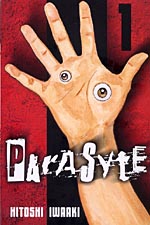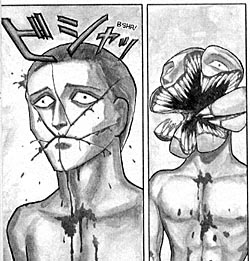 By Hitoshi Iwaaki
By Hitoshi Iwaaki
288 pages, black and white
Published by Del Rey
I remember reading early volumes of Parasyte almost a full decade ago, when TokyoPop published its first English-language edition. It was a fun if slightly forgettable series, with ideas about invasive shapeshifting aliens and inventive visuals. With Del Rey bringing the series back into print in an eight-volume edition (TokyoPop’s version was 12 volumes and reversed to read left-to-right), though, it’s surprising what a difference the series has when read in today’s political climate. What was once amusing is now much more compelling with the idea of a world full of people that may be undercover killers.
A cluster of alien life forms lands on the earth, each parasite burrowing into an unsuspecting host’s brain and consuming/merging with it, taking over the body before dismembering and devouring other humans. Shin at first seemed to be the lucky one; the parasite that attacked him was only able to take over his right hand, leaving Shin still in control of the rest of his body. Now Shin and his parasite are stuck in an uneasy truce, though; the other parasites want to kill this new gestalt being and can sense his presence even as they hunt him, and if any other humans discovered Shin’s new nature he’d certainly end up on a lab table. No, Shin is feeling anything but lucky these days.
 With the rising fear of sleeper agents and covert operations, it’s a perfect time to bring Parasyte back into print. The idea of everyone from the person down the street to your friend’s teacher possibly being a killer waiting to strike is a chilling one under the best of circumstances, but for people already paranoid abut that in the real world, Parasyte will be nothing short of a nightmare come to life. Shin’s nervousness over being discovered by either side comes across entirely believable; Hitoshi Iwaaki has placed Shin in a situation where he really does have no one that he could turn to, instead a reluctant collaborator trying to save himself, his parasite, and the rest of humanity all at once. With each chapter, Iwaaki manages to raise the tension and nervousness, forever adding in new situations that shows variations on both the type of host-body-takeover, as well as intelligence levels and motives of the parasites. It’s enough to make sure you don’t get bored any time soon. Special note also has to go to the new translation of Parasyte; it wasn’t until I got a copy of the old series and compared it to the new one that I saw how much smoother and reasonable this rewrite is.
With the rising fear of sleeper agents and covert operations, it’s a perfect time to bring Parasyte back into print. The idea of everyone from the person down the street to your friend’s teacher possibly being a killer waiting to strike is a chilling one under the best of circumstances, but for people already paranoid abut that in the real world, Parasyte will be nothing short of a nightmare come to life. Shin’s nervousness over being discovered by either side comes across entirely believable; Hitoshi Iwaaki has placed Shin in a situation where he really does have no one that he could turn to, instead a reluctant collaborator trying to save himself, his parasite, and the rest of humanity all at once. With each chapter, Iwaaki manages to raise the tension and nervousness, forever adding in new situations that shows variations on both the type of host-body-takeover, as well as intelligence levels and motives of the parasites. It’s enough to make sure you don’t get bored any time soon. Special note also has to go to the new translation of Parasyte; it wasn’t until I got a copy of the old series and compared it to the new one that I saw how much smoother and reasonable this rewrite is.
As strange as it might sound, if it wasn’t for the parasites in Parasyte, Iwaaki’s art would be pretty unmemorable. Fortunately, as the parasites are the main thrust of the series, that’s also where Iwaaki’s big strength is. From heads that unwind into a killing spiral, to unfolding like a starfish, each attack from the parasite is slightly different and no less terrifying. It’s a nice contrast to Migi, the parasite in Shin’s right hand. Iwaaki draws Migi in a cartoonish, almost-goofy manner which helps lull the reader into a false sense of security about both Migi and the parasites themselves. As the other parasites reveal their true colors, though, or Migi itself attacks, it’s a nice shock to the system to see just what they’re really designed for. As for the rest of the art, while it is slightly unremarkable, it’s in a good way—a strong sense of anatomy and well-drawn if perhaps average characters.
A long-forgotten series that was published before the English-language manga sales boom hit, it’s nice to see Parasyte get a second lease on life. A little thicker in page count than most books from Del Rey Manga, it’s got the usual strong production values associated with the line and it’s all-in-all a good, strong series. For those looking for a healthy mix of paranoia, aliens, suspense, and violence, Parasyte is the answer to that search.
Purchase Links:
